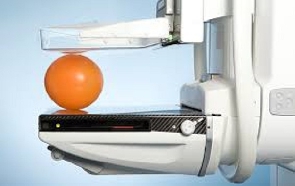I spent a year working at Tamale Teaching Hospital as a doctor. In my line of duty, I came across several situations which I felt were drawbacks in healthcare regarding the fight against breast cancer; one of which was the lack of a functioning mammography unit allegedly for the past 5 years. Throughout my working life in the hospital, the mammogram never worked. Not all my experiences as a health professional in the hospital were bad but this was one situation that baffled me.
Here is a little overview of the hospital. Tamale Teaching Hospital is a health facility in the Northern region of Ghana that serves as a major referral site for all five regions in the northern part of Ghana. The hospital has various departments including but not limited to surgery, medicine, obstetrics and gynaecology, public health and dental.
The department of surgery is where most breast cancer patients are seen, managed or referred when the need arises. A 2018 study by Der et. al which looked into cancer patterns within the Tamale Teaching Hospital over 6 years revealed that breast cancer cases were the most common cancer cases seen in females making up about 33.5% out of the 715 cases reviewed [1]. This study corroborates the relevance of this article in that, obtaining a functioning mammogram would help in the early detection of the most common cancer encountered among females presenting to the hospital and ensure that lives are not lost due to the delay in diagnosis and hence delay in treatment.
Breast cancer is defined by the Centres for Disease Control and Prevention as an illness where the cells of the breast grow abnormally or in medical terms become malignant. This disease is more common in women above 40 years with a high mortality rate with a 69.7% 5-year specific survival rate compared to older groups [2]. A study by Arnold et. al found that breast cancer was the most diagnosed form of cancer in the world as of 2020, 2.26 million people were newly diagnosed and there were 685,000 mortalities in the same year globally [3].
The GLOBOCAN 2020 report showed that Ghana had 4,482 (18.7%) new cases of breast cancer which has doubled as compared to the data obtained in 2012. Half of those diagnosed died and this was as a result of late presentation according to the GLOBOCAN report [4]. These statistics mean that a lot more people in Ghana are being diagnosed with breast cancer hence the need for intervention as more lives are being lost as a result of this disease.
Early detection can be achieved for women over 35 years via a mammogram and ultrasonography of the breast for those under 35. Mammography is the use of an x-ray to image the internal structures of the breast to detect breast cancer usually in older women above 35 years. This is because of the difference in the density of breast tissue in older women as opposed to younger women.
A mammogram examination is the preferred tool (the gold standard) for screening of breast cancer every 2 years for the appropriate age group and helps in detecting a tumour of the breast especially when the tumour is smaller in size and might be difficult to detect when feeling for lumps one’s hand. [5,6]. An ultrasound is an imaging device that utilizes sound waves to create a picture of structures in the body.
This test is usually used to detect early stages of breast cancer in people younger than 35 years. A combination of an ultrasound and a mammogram can be used to detect breast cancer in denser breasts or people younger than 35 years in screening and diagnostic exercises [5].
The dysfunctional mammogram and the unavailable ultrasound after 12 pm
One afternoon during my duty at the outpatient department (OPD) as part of my surgery rotation, I came across a patient who had signs of breast cancer and needed a mammogram for prompt initiation of treatment and mitigation of disease progression. So as usual, I decided to discuss the case with a senior colleague to agree on the way forward.
I had the shock of my life (in this case my career), when I was told that the hospital did not have a working mammogram to help us detect what stage the disease was and hence treatment could not be initiated without the imaging being done. Therefore, the patient had to be redirected to another teaching hospital in either Kumasi or Accra where the mammogram could be done which is about 381km and 622km respectively from the Tamale Teaching Hospital. In other words, this was a very far distance and tiring journey for a sick person to embark on.
The patient had challenges because she had no family in any of those regions and had to bear the cost of accommodation, travel and other expenses in addition to the cost of having the mammogram done. Many patients suspected to have breast cancer also face a similar plight so they may end up not returning for treatment due to the hectic nature of even getting a diagnosis.
Therefore, the next time this patient appears in the consulting room might be in the late stage of the disease which is unacceptable because the lack of a mammogram is highly preventable and it is a problem that can and needs to be solved urgently.
In addition, there is an ultrasound machine in the Tamale Teaching Hospital, which is allegedly not available to be used on patients after noon due to alleged understaffing. Therefore, a patient coming to be tested or screened for breast cancer after the stated time is not likely to get access to the facility and if that patient does not show up again, the opportunity to diagnose and treat the patient might be missed.
Also, the inaccessibility of the ultrasound facility after the said time affects pregnant women and people with other issues requiring ultrasonography to aid in diagnosis as most of them can be seen crossing the road to other facilities that have an ultrasound during the day and night. What if these people get knocked down by a vehicle or get into some sort of accident in the name of seeking an ultrasonographer (a person who has the expertise to operate the ultrasound and interpret images) and end up creating a new problem while trying to solve another?
The way forward
Initially, I expressed my shock to a worker at the hospital and the response was “That is the way it is”. I decided I did not want it to be like that so I verbally complained to one of the administrative authorities. Eventually, it became clear to me that the issue was not new to them as well and throughout my entire year of working at the hospital, the mammogram did not work and the norm of referring patients to either Accra or Kumasi hospitals continued.
I decided to probe further concerning how long the mammography unit had been dysfunctional and I was told that it has allegedly been over 5 years now. I was not given any reasons as to why this was so and when it was intended to be fixed. The only way forward is for the hospital to garner resources to fix the mammography equipment and ensure that the ultrasound machine is operating at all times.
There were other major issues I also experienced while working in the hospital which include but are not limited to – lack of gloves to work especially during weekends at the surgical unit, lack of cannula to set up intravenous fluids and for the administration of medications, and more recently – lack of water and sterile items for performing surgeries.
The lack of a functioning mammography unit and the presence of an ultrasound machine that becomes unavailable to patients after noon is not helpful and serves as a drawback in the fight against breast cancer and therefore needs urgent resolution. It is not enough to just talk about breast cancer screening as a hospital and not have the facilities to help people when they come for screening.
It is unacceptable for these things to be going on for years with nothing being done to the point where people are tired of complaining and eventually develop an attitude of apathy or acceptance that things are going to remain the same. Meanwhile, there are Members of Parliament in the area and there is a Minister of Health with deputies in this country.
There are also workers whose responsibility is to ensure that these issues mentioned are resolved but are sitting aloof. This is what is going on in the Northern part of Ghana and it would be inhumane to look the other way.
References
1. Der EM, Ibrahim MM, Buunaaim ADB, et al. Baseline Study of Cancer Patterns in the Department of Pathology of the Tamale Teaching Hospital, Northern Region of Ghana. J Adv Med Med Res. 2018;27(9):1-14. doi:10.9734/JAMMR/2018/43772
2. Chung M, Chang HR, Bland KI, Wanebo HJ. Younger women with breast carcinoma have a poorer prognosis than older women - PubMed. Cancer. 1996;77(1):97-103. doi:10.1002/(SICI)1097-0142(19960101)77:1<97::AID-CNCR16>3.0.CO;2-3.
3. Arnold M, Morgan E, Rumgay H, et al. Current and future burden of breast cancer: Global statistics for 2020 and 2040. Breast. 2022;66:15-23. doi:10.1016/j.breast.2022.08.010
4. Observatory GC. Ghana Source: Globocan Incidence, Mortality and Prevalence by cancer site. Published online 2021:1-2.
5. Geisel J, Raghu M, Hooley R. The Role of Ultrasound in Breast Cancer Screening: The Case for and Against Ultrasound. Semin Ultrasound CT MR. 2018;39(1):25-34. doi:10.1053/J.SULT.2017.09.006
6. Hela B, Hela M, Kamel H, Sana B, Najla M. Breast cancer detection: A review on mammograms analysis techniques. 2013 10th Int Multi-Conference Syst Signals Devices, SSD 2013. Published online 2013. doi:10.1109/SSD.2013.6563999
Opinions of Saturday, 14 January 2023
Columnist: Dr. Naa Adzoa Adzeley Boi-Dsane















